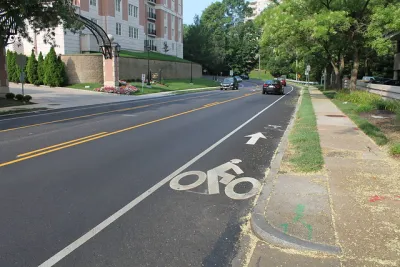The new form-based zoning code under consideration in the affluent Philadelphia suburb of Lower Merion "has something to teach Philadelphia and other big cities about how to organize density smartly," according to Inga Saffron.

Inga Saffron writes of the new zoning code in the Philadelphia suburb of Lower Merion as an example of the "conflicted soul of the suburbs"—that is, the conflict between a contemporary push for more inclusionary land use regulations with the status quo of politics ruled by residential property owners.
Lower Merion's new zoning code will face a final vote by the Board of Commissioners on September 18. "The rules," writes Saffron, "enshrine some of the most cherished — and exclusionary — features of 1950s suburbia. Big lots. Big houses. Big requirements for off-street parking. Affordable housing and sustainable construction barely rate a mention."
That seems like a full expression of the suburban status quo, but there is one visible sign of reform more in keeping with more recent planning trends: "Lower Merion is also going further than most of its peers to create pockets of density near transit and encourage walkability throughout the township," according to Saffron. Accessory Dwelling Units will also be legalized by the new code. Saffron notes that Philadelphia has only just begun to tackle that issue.
Lower Merio hired Elizabeth Plater-Zyberk, co-founder of the Congress for New Urbanism and Lower Merion native, to write the new zoning code. It follows, then, that Lower Merion's new code is of the form-based variety. Saffron explains:
Because Lower Merion was built around the Pennsylvania Railroad’s “Main Line,” it has always been a unique urban-suburban hybrid, with dense, transit-oriented villages like Ardmore and Bryn Mawr, and rolling country estates farther out in Gladwyne and Penn Valley that are totally car-dependent. The form-based code treats the two halves as different places, preserving the storybook version of the Main Line while still allowing density near the train stations.
The article includes insight from Plater-Zyberk about the city and the new code.
FULL STORY: Lower Merion’s new zoning code is a love letter to suburbia | Inga Saffron

National Parks Layoffs Will Cause Communities to Lose Billions
Thousands of essential park workers were laid off this week, just before the busy spring break season.

Retro-silient?: America’s First “Eco-burb,” The Woodlands Turns 50
A master-planned community north of Houston offers lessons on green infrastructure and resilient design, but falls short of its founder’s lofty affordability and walkability goals.

Delivering for America Plan Will Downgrade Mail Service in at Least 49.5 Percent of Zip Codes
Republican and Democrat lawmakers criticize the plan for its disproportionate negative impact on rural communities.

Test News Post 1
This is a summary

Test News Headline 46
Test for the image on the front page.

Balancing Bombs and Butterflies: How the National Guard Protects a Rare Species
The National Guard at Fort Indiantown Gap uses GIS technology and land management strategies to balance military training with conservation efforts, ensuring the survival of the rare eastern regal fritillary butterfly.
Urban Design for Planners 1: Software Tools
This six-course series explores essential urban design concepts using open source software and equips planners with the tools they need to participate fully in the urban design process.
Planning for Universal Design
Learn the tools for implementing Universal Design in planning regulations.
EMC Planning Group, Inc.
Planetizen
Planetizen
Mpact (formerly Rail~Volution)
Great Falls Development Authority, Inc.
HUDs Office of Policy Development and Research
NYU Wagner Graduate School of Public Service





























